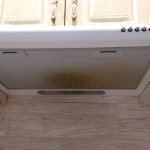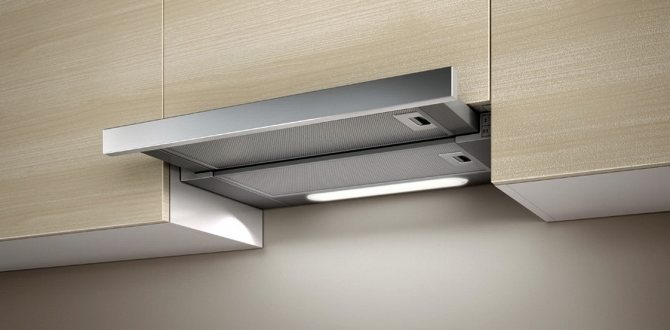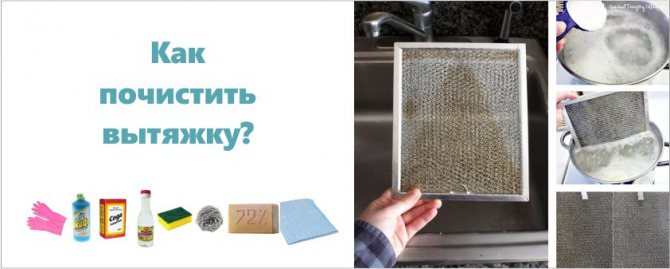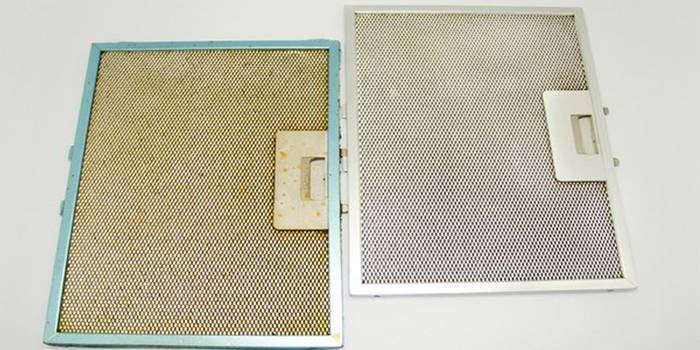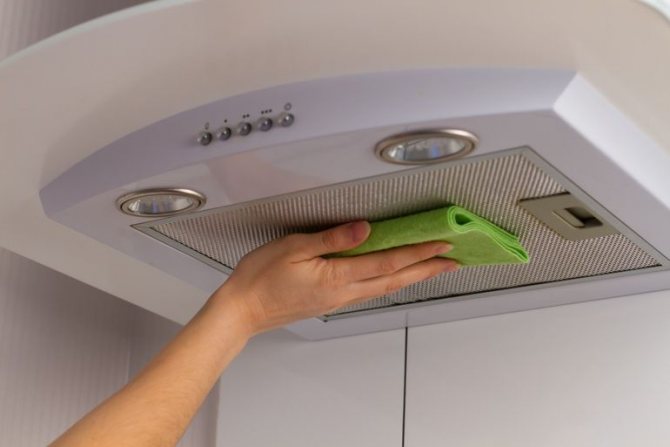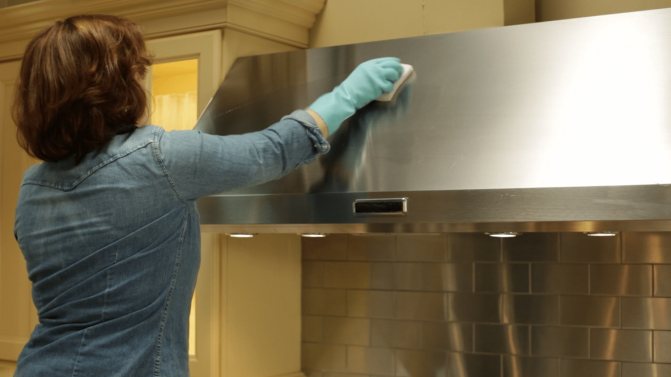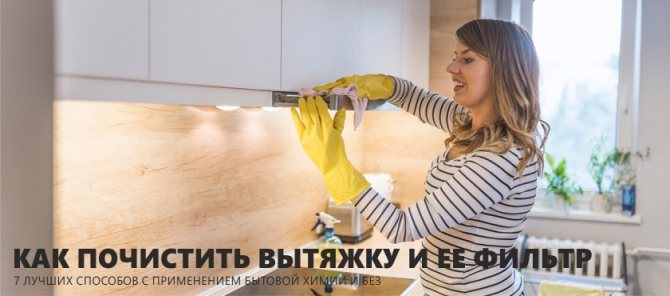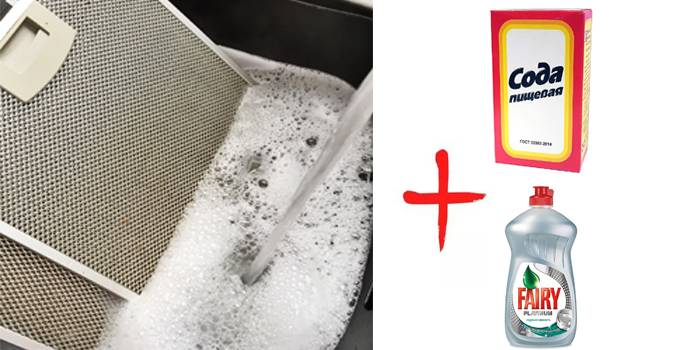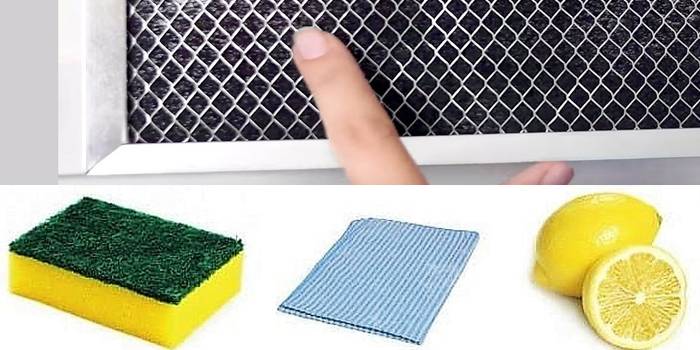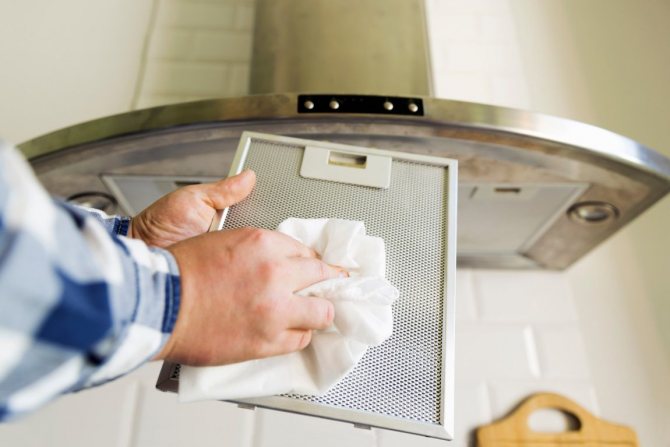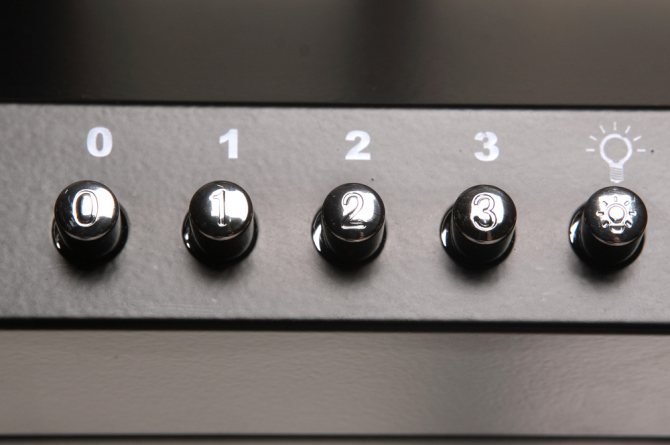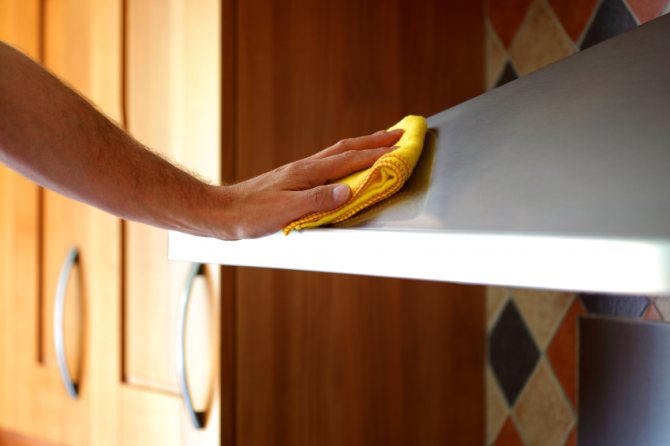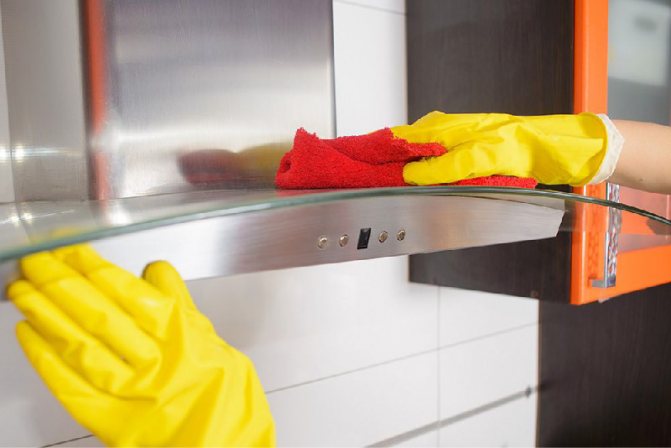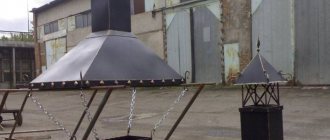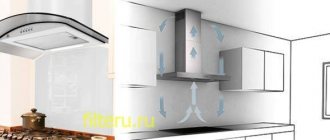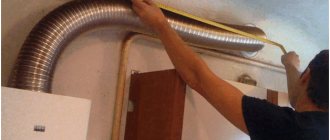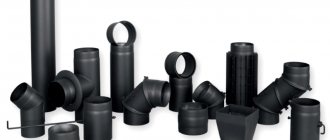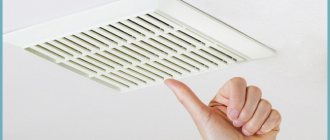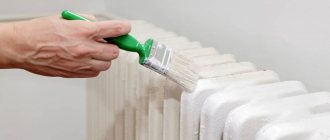Any household appliances that are purchased into the house require careful maintenance. A cooker hood installed over a gas or electric stove is no exception.
This device takes on a lot of air purification in the apartment. One of the requirements for safe operation is the timely cleaning of all structural parts. You can clean the hood in the kitchen using different methods and tools.
Why you need to clean the hood
A fume hood clogged with grease, dust, and soot creates numerous problems. First, a dirty hood filter stops performing its direct functions. Catching steam, odor, smoke practically stops. The operation of the device becomes useless. Secondly, this creates an increased load on the engine and the risk of its breakdown increases significantly. Third, excess fat is a potential fire hazard.
In addition, there are accompanying reasons that do not directly affect the operation of technology, but create inconveniences for life. These include the increased noise that the motor produces when the filters are clogged with dirt and an unsightly aesthetic appearance. Periodic cleaning of the hood is a prerequisite for its trouble-free and maximum useful work.

How to disassemble the device?
In the instructions for the unit, the manufacturer indicates which parts are removable / dismountable and encloses a diagram of the device. Focusing on the diagram, even a woman can disassemble.
If there is no instruction, it is worth using the standard algorithm, it may also work:
- The device is disconnected from the mains.
- Snap off the latches and remove the top case cover.
- Remove the filter.
- Remove the tube that connects to the vent.
- Disconnect all removable parts and take out the air filter.
Collapsible parts are soaked in a large container with soapy water for a couple of hours. After the allotted time, rub it intensively with the hard side of a kitchen sponge and wash under warm running water.
A soapy solution is made from dish soap or hand wash powder (it produces more foam).
How often to clean
The clogging rate of the fume cupboard filter directly depends on the frequency of cooking on the stove. Additional pollution is brought in by tobacco smoke if people smoke in the kitchen. Therefore, the question of the frequency of cleaning is relevant for everyone who has this household appliance installed. Many modern models are equipped with special sensors. Blinking on the display of the letter "C" or the grill sign signals that it is time to take up detergents. Under standard conditions, the reminder is triggered after 60 hours of engine operation. But the sensor can be configured independently for a certain period.
If the design of the equipment does not imply the presence of a sensor, then the hood is cleaned at least once a month. If the stove is used often, then the frequency of cleaning is increased to two times a month. It is not recommended to neglect this rule, since it is more difficult to wash off grease from a heavily soiled filter mesh.


Some compact models do not have reusable metal filters, but disposable ones, which are made of paper, acrylic, non-woven or synthetic winterizer. Such filter inserts are not washed, they are replaced with new ones every 3-4 months. The same goes for charcoal filters, which finely clean the air. They are replaced with new ones about once a year.It is recommended to thoroughly clean the hood from fat with a complete disassembly of the device and lubrication of engine parts once a year, and with intensive use - once every six months.
Tips on how to avoid heavy dirt on the hood
Once faced with serious old greasy spots on the hood, housewives dream of making it easier for themselves the process of washing them. But is it that simple?
- It is recommended to clean the hood once every 1 month. Then the kitchen will always be clean, and you can forget about oily stains;
- When the hood is washed and dried. It must be disabled. Then both the hostess and the unit itself will be safe;
- Do not heat up the cooker hood. Before boiling (if provided by the cleaning recipe), you need to check the part for plastic elements. After all, they can melt;
- It is better to get rid of dirt when they are still fresh. Even a simple soap solution will be enough, with which simple stains can be easily rubbed off. Therefore, you should not delay cleaning. Better once a week, a little bit and it is easy to wash the hood;
- It is worth taking care of your hood regularly. Then it will work much more efficiently. And the question of how to wash the hood from fat will no longer arise. No additional spending on professional funds will be required.
Preparatory work and disassembly of equipment
To get to the internal parts of the device, namely, they are subject to washing, it is necessary to disassemble the hood. In the process of disassembly, a certain order of actions must be followed:
- The very first step is to disconnect the appliance from the mains.
- Next, remove the top panel of the case. To do this, you need to snap off the latches.
- Take out a mesh that covers the filter element.
- Remove the hood filter itself. To remove the horizontally located filter, it is necessary to put the switch in the "roll-out" position. To reach the vertical filter mesh, slide out the tray.
- At the next stage, the pipe is unscrewed, which removes dirty air into the duct.
- Then they start cleaning all the elements and parts of the kitchen hood.
Before analyzing the equipment, it is recommended to carefully read the instructions that come with the kit.


Preparatory activities
Do not leave the hood on when washing, you may get an electric shock.
- Prepare the necessary tools and the appliance itself for contact with water. To do this, be sure to unplug it from the outlet. Remove the parts that are mechanically attached (decorative glass, grilles, control knobs).
- The pipe that goes through the wall to the street also requires processing, we remove it according to the instructions for the device. If it does not work out on your own, ask family members or contact the master.
- Take out the air filter, it also needs cleaning. If there are loosening parts on it, remove them, but remember the sequence for further installation.
- Do not try to pull the hood body out of the wall, it can be washed right on the spot using soap, degreasing agents or folk recipes, but more on that below.
- Determine the degree of contamination of the household appliance and select the desired method for removing greasy deposits. Perhaps an ordinary soap solution will help you, or the use of household chemicals will save you.
We suggest that you familiarize yourself with We understand whether it is possible to keep chickens and rabbits together
If some parts do not open (often filters), do not tempt fate, most likely, they must only be replaced
Before cleaning the hood, you must arm yourself with the manufacturer's instructions for the device and familiarize yourself with the manufacturer's recommendations for care and operation. The paper should indicate how often the hood should be cleaned and what products are suitable for cleaning.
Processing is carried out only after the device is completely de-energized.Therefore, you will have to figure out how the hood turns off - otherwise, if liquid gets inside the case, you risk getting a short circuit and an electric shock.
Is there an extractor hood in your kitchen?
Methods and means of cleaning the hood from fat
Method 1. Washing in the dishwasher
This is one of the easiest ways to clean the hood. But only those with a dishwasher can choose it. But even if this technique is available, it does not always work. Too large and old layer of fat is not washed off during an automated wash. To remove fresh contamination from the filter, set a mode with a maximum time period and a temperature of 60 degrees. One wash cycle is usually sufficient.
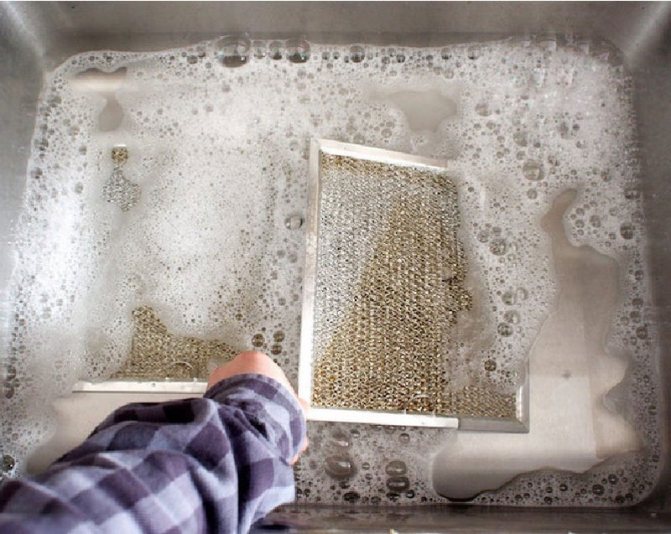

Method 2 Dishwashing liquid
Fume cupboard manufacturers recommend cleaning the grease grates and all cabinet parts with mild detergents. If the technique is washed from fat on a regular basis, this method works perfectly. It is enough to pour warm water into a large container, add dish degreaser and soak the filters. After 20-30 minutes, remove all dirt with a sponge and rinse under running water.
To make fat easier to remove from the mesh, it must first be soaked
Method 3 Soap-soda solution
Contamination is not the first freshness is difficult to give in to such means as "Fairy", "Myth", "Gloss". They need stronger cleansing additives. This could be baking soda. The washing technique is simple. The container (the sink can be used) is filled with hot water (preferably boiling water), soda is poured (about a quarter of a glass per 10 liters of water), a little detergent is added. Stir the liquid until foam forms and put a filter in it to soak. When the water has cooled to warm, clean the mesh with a sponge or soft brush.
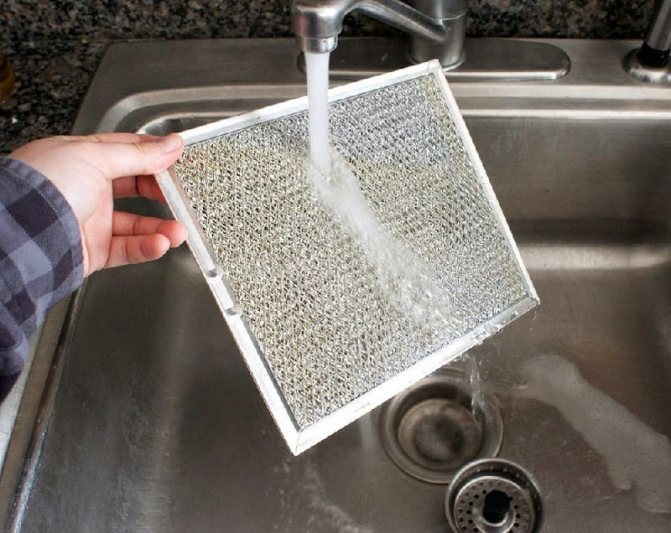

Method 4 Boiling in a soda solution
This popular home method is also used when you just need to clean the hood. You don't even have to scrub anything from the surface. Pour water into a large saucepan or bowl, bring it to a boil and pour soda (10 liters glass). The gas is reduced to a minimum so that the liquid does not boil very much, since the soda solution has a habit of "running out" from the container. The filters are placed in a saucepan. When the grate is completely free of dirt, it is removed with tongs and washed.
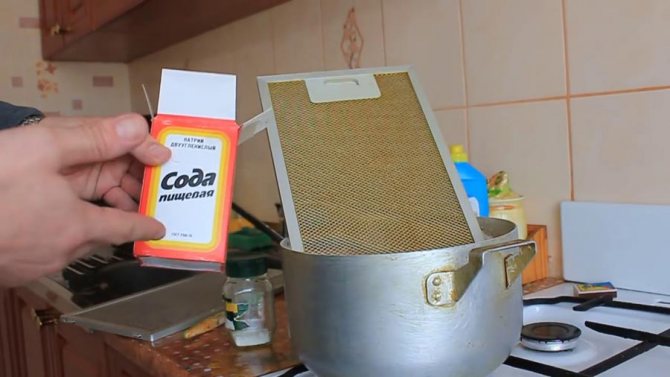

Method 5 Pipe cleaners
If it is necessary to clean the hood, the filters of which have not been touched for too long - more than a few months, then it is better to choose purifiers containing active chemical compounds. This is exactly what means for blocking pipes. If the reagent is in powder, then 2-3 sachets will be needed, if in liquid - 1/2 cup.
To remove the fat from the hood filter, place it in a low container (for example, a baking sheet) and fill it with hot water. Then evenly fall asleep or pour in the cleaner. The exposure time is 10 minutes. When using pipe cleaners, be aware that they should not be used more than twice a year. First of all, this concerns aluminum filters, since this material is chemically less stable than steel.
When working with strong chemicals, be sure to wear rubber gloves and open the window!
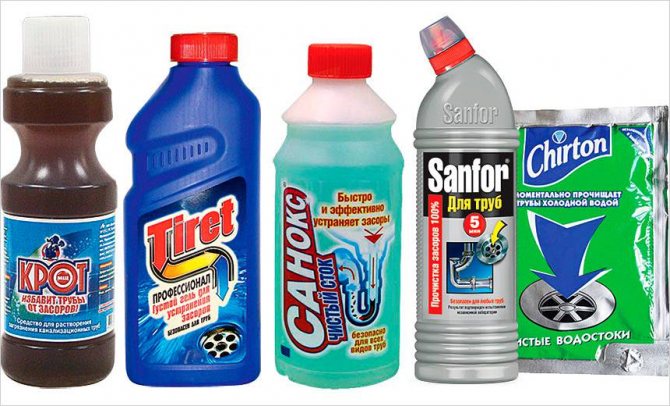

Method 6 Oven cleaner
You can also quickly remove grease from your cooker hood with an oven cleaner. This option is considered similar to the previous one. For work, a gel is taken, designed to remove fat from baking sheets and the inner walls of the oven. The gel is poured onto an exhaust grate and, using a brush, is spread evenly over the surface. After the time specified in the instructions (usually 20-30 minutes), the mesh is cleaned. The final touch is rinsing with clean water. The safety rules when working with this aggressive compound are the same - the use of protective rubber gloves and an open window.
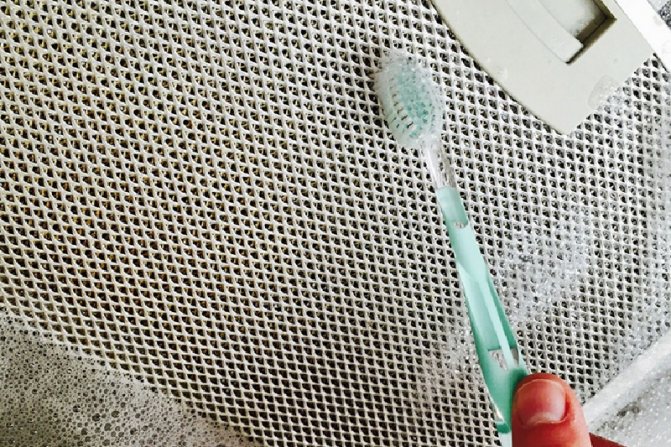

The second, fifth and sixth methods describe the use of agents that are ready-made special cleaners for household appliances and dishes. They all work in different ways. To save your time and not experiment in vain, watch the following video. In it, three store tools were tested in practice:
Method 7 Laundry soap
To clean the hood in the kitchen from the fat that has accumulated recently, ordinary laundry soap will help. It is one of the most environmentally friendly and non-allergenic products. For work, you need a soapy solution. It is made with 5 liters of hot water and one bar of soap. So that the soap dissolves well and quickly, it is rubbed on a coarse grater or the pieces are soaked in water in advance, and then it is heated. The mesh is dipped into the solution and kept there for at least half an hour. Further cleaning is carried out with a brush or household sponge.
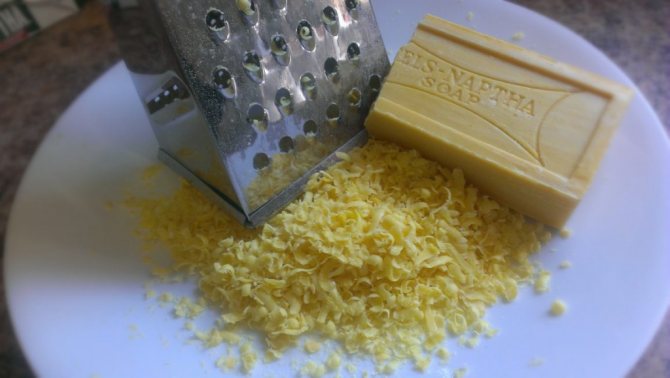

Method 8 Laundry soap with soda
To clean the hood in this way, you need to add 2-3 tablespoons of baking soda to the previous recipe. Under the action of two cleaners, the fat is quickly soaked and removed from the mesh surface. The method is more time consuming than using, for example, pipe flushing agents, but easier than using laundry soap alone.
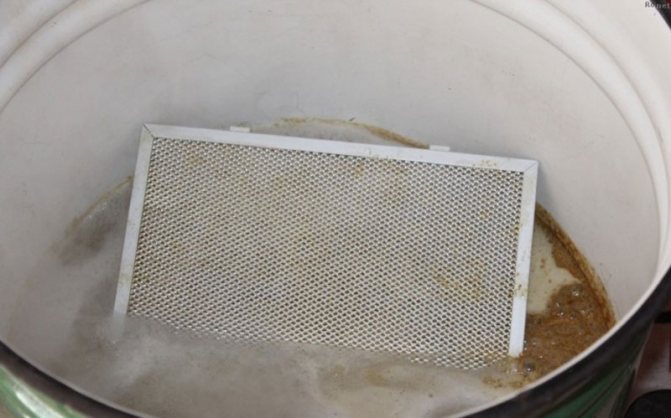

Method 9 Vinegar
To remove soot and fat, a 9% vinegar solution is taken. A cloth or sponge is moistened in it, and then the entire filter mesh is wiped. To prevent the solution from drying out, it is advisable to cover the entire surface with the same rag. After 10-15 minutes, you need to wash off the removed contamination with water. If the old plaque has not left the first time, the technique is repeated. Despite the low concentration, the vinegar requires the use of gloves.


Method 10 Lemon
This natural product is not only a source of vitamin for humans, but also strong organic acids, primarily citric acid. It is she who is the reagent. To clean the hood, 1-2 fruits will be enough. They are cut in half and the contaminated parts are wiped with a cut. You can additionally squeeze out the juice and also apply it to the mesh. The exposure time of the lemon treatment is about 10 minutes. If the desired effect was not obtained the first time, then the technique is duplicated or an additional home recipe is used.
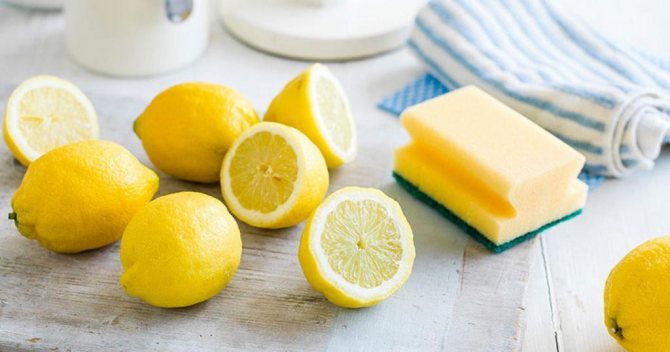

Method 11 Citric acid
For those who consider lemons too much of a luxury to clean their hoods, a concentrated analogue, citric acid, will do. To prepare "lemon" in a liter of hot water, dissolve three large tablespoons of acid powder. After complete dissolution, the mesh should be put into the solution for 15-20 minutes. In some particularly problematic cases, you have to use a brush or repeat the procedure.


Method 12 Ammonia
Ammonia is not only a medicinal product, but also an economic one, since it can also act as an anti-fat. According to the method of use, it is necessary to pour 100 ml of ammonia into 3.5 liters of warm water (with a temperature of about 50-60 degrees). The filter is soaked in this reagent for three hours (for persuasiveness, the soak can be extended to four hours). After soaking, the dirt is cleaned off with a brush, then the mesh is thoroughly rinsed with water. It is very important to open the window before starting work and use a gauze bandage during the procedure itself.
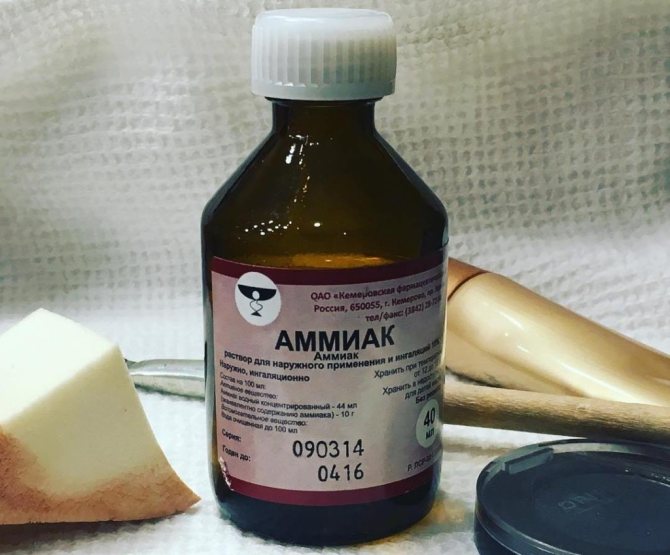

Method 13 Vinegar-ammonia-citric acid
If the case is most neglected and ordinary soapy water does not cope, then a more complex combined recipe should be used. The combination of three ingredients at once, two of which contain organic acids, increases the efficiency of washing away old fat. The composition of the components in this super powerful reagent is as follows:
- water - 1 liter;
- citric acid - 3 tablespoon;
- vinegar (9%) - 1 glass;
- ammonia - 1/2 cup.
All these components are added to warm water and they keep dirty parts for 10-15 minutes.This is followed by the traditional cleaning with a sponge or soft brush.
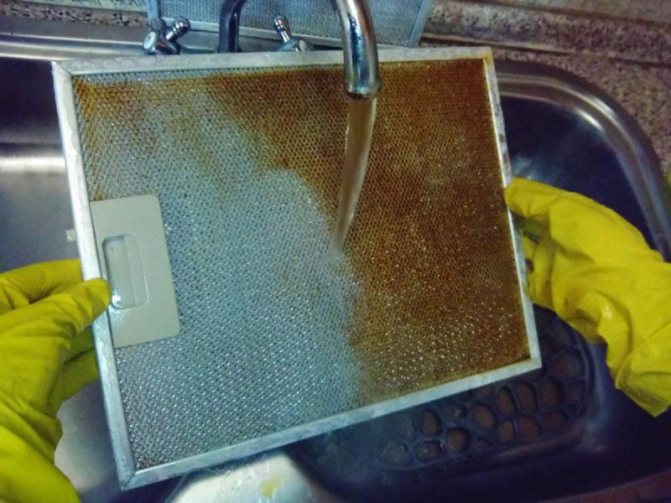

Method 14 Mustard powder and vinegar
A mustard recipe helps to clean the hood filter. To do this, dissolve dry mustard powder in a small amount of warm water. Vinegar and a few drops of dishwashing liquid are added to the creamy gruel. The vinegar should be about twice the amount of water taken. Stir the mass and apply it in an even layer on the filter. Apply mustard paste on both sides of the wire rack. After 20-30 minutes, wash off. Use a brush if necessary.
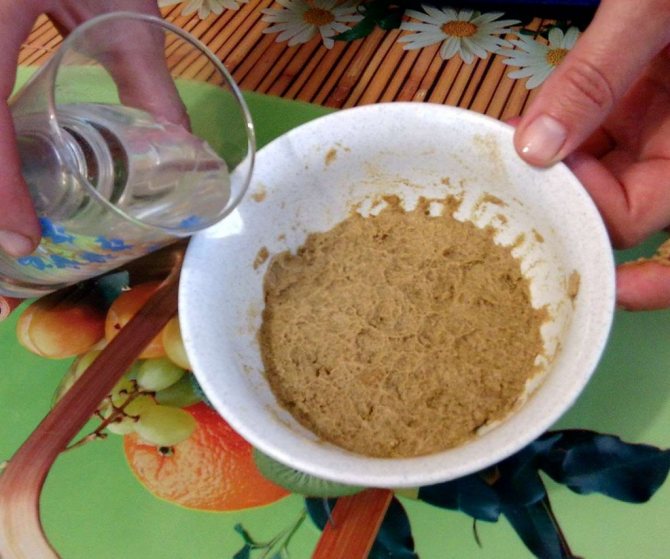

Method 15 Mustard and detergent
The previous recipe is sometimes modified: instead of vinegar, dishwashing detergent is taken. Both components complement each other and enhance the degreasing effect. Mustard powder is diluted in warm water to a mushy state, and then a little soap is added. Mix the mass well to a foamy state and apply it to problem areas. After 20-30 minutes, you need to wash the filter.
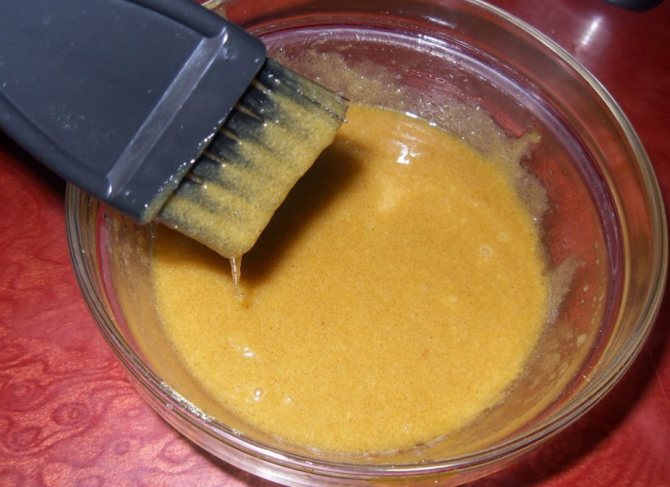

Method 16 Soda, mustard and detergent
Instead of an acidic reagent, an alkaline reagent can be added to mustard powder. Baking soda is good for this. The fat-solvent is prepared according to a similar scenario. First, the powders (mustard and soda) are dissolved in warm water, and then liquid soap is added. Rub both sides of the filter with this pasty mass and let it lie down. Then clean it off with a brush or sponge.
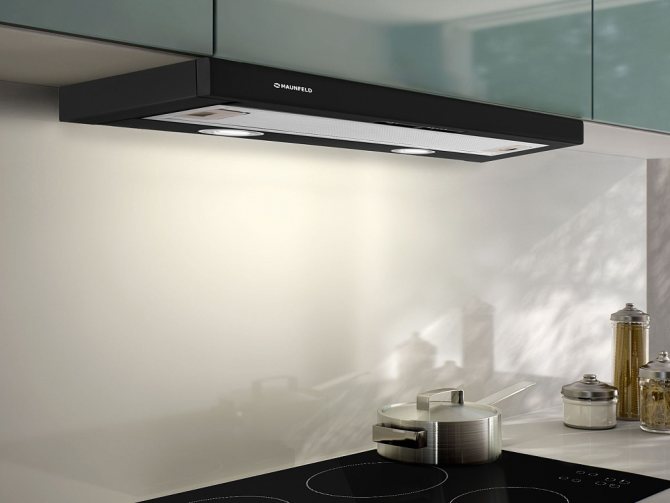

Method 17 Cola
It is known that imported carbonated drinks such as Coca-Cola or Pepsi contain substances that actively corrode organic pollution. That is why they can be used to effectively clean the cooker hood without wearing protective gloves or opening wide windows. The hood filter is placed in a low flat container and completely filled with a drink. Leave in this form for several hours. The degree of fat loss should be checked periodically with a wooden scraper. After the end of soaking, the mesh is washed with water using a sponge.
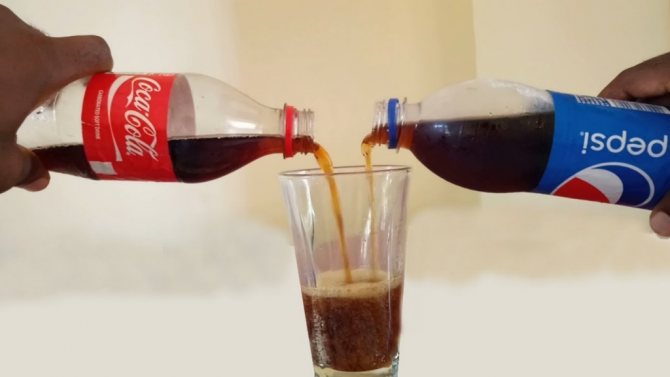

Method 18 Whiteness
A liquid designed to bleach white towels and sheets also comes in handy in the kitchen. With its help, it is easy to wash off surface contamination of the device case. It is also possible to clean the internal parts, provided there is fresh accumulation of grease and dirt. Work must be carried out with gloves with an open window. Using a sponge or brush, spread the whiteness over the surface. Withstand 15-20 minutes and wipe with a sponge. For tougher spots, you will have to make an effort.
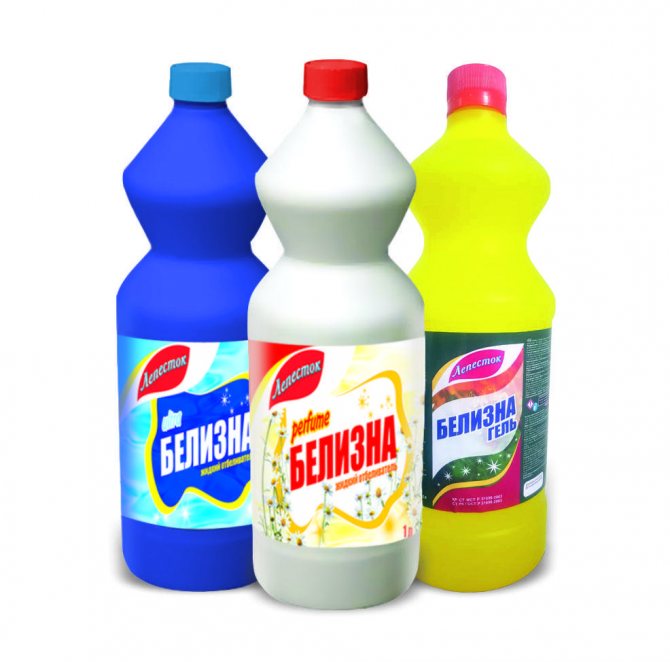

Method 19 Special grease removers
In addition to gels for cleaning sewer pipes and removing carbon deposits from ovens, there are special grease removers. They are washed in cases where the fat is not just deposited on the surface of objects, but under the influence of temperature and dirt has turned into a hard-to-remove plaque. You should use one or another grease remover according to the attached instructions. The line of such special equipment includes:
- Bugs make noise;
- Giant bugs;
- Sparkling cauldron;
- Oven Cleaner;
- Frau Gretta.


Method 20 Steam generator
A steam generator completes the top efficient ways. This method can be compared to a dishwasher, since it involves the use of household appliances for washing. Of course, the steam generator is only suitable for those who already have it in the house. The advantage of this method is that it can be used by people with hypersensitivity to various chemicals. Since the steam supplied by the generator has a very high temperature (about 150 degrees), the fat melts without any reagents. After processing, it remains only to wash the surface with soap and dry.
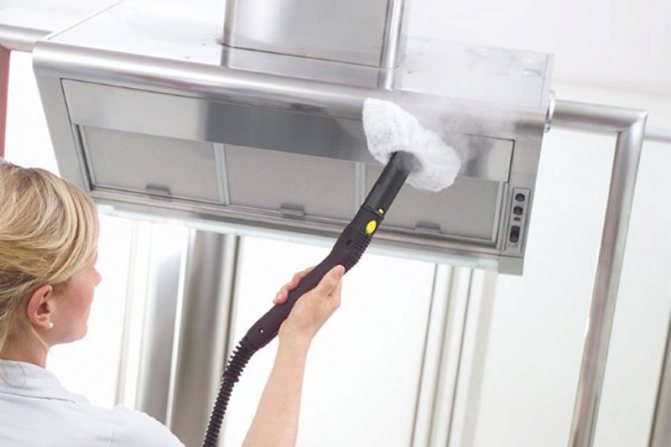

What can not be cleaned
Since the surface of the fume cupboard and the filters themselves are made of metals or their alloys, many strong substances cannot be used.All liquids based on strong alcohol, acetone, nail polish remover, and solvents are taboo. These products can cloud the steel surface or get permanent streaks. When cleaning the hood, it is not recommended to use coarse abrasive powders, as well as hard brushes designed to remove carbon deposits (for example, metal sponges or scrapers).
Strong household chemicals
Sometimes the grill of the hood is so clogged with old fat that it resembles the grill of a hive with honeycombs. In especially advanced cases, this fat starts to drip onto the stove.
In such cases, folk remedies will not help much, you need to connect "heavy artillery" - household chemicals.
Now we will tell you how to clean the hood in the kitchen from heavily ingrained and old fat with the help of such modern potent agents.


The arsenal of such chemistry is more than impressive. We advise you to pay attention to such means as:
- foam intended for cleaning ovens, grills, TOPCleanner or PowerWash braziers;

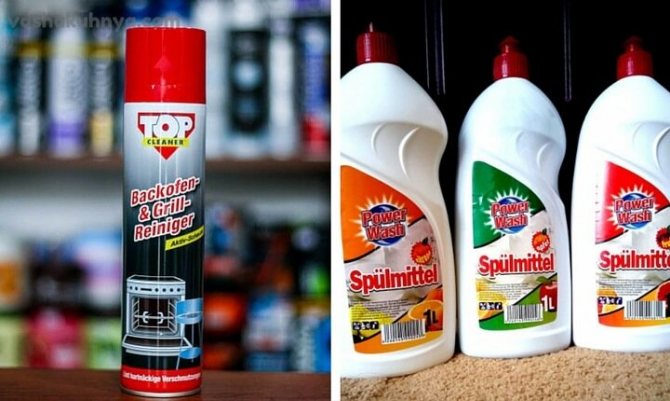
- oven cleaner from Amway;


- gel for hobs and stoves Sanita, Milam;

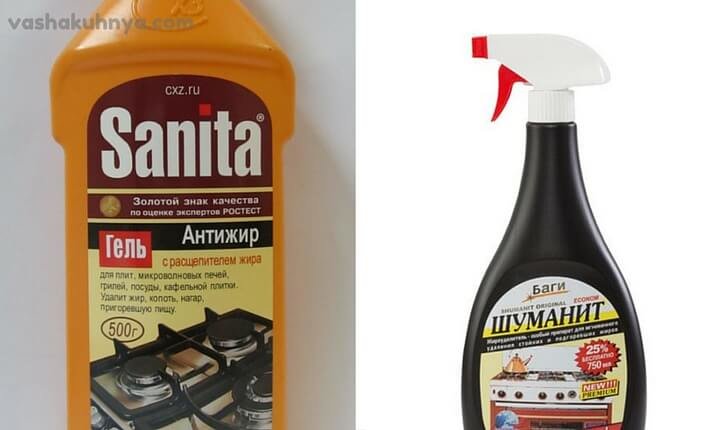
- cleaning powders, in particular Bagi Shumanit.
When dealing with any household chemicals, especially such aggressive ones, do not forget to use rubber gloves that will protect the skin of your hands from chemical burns.
Another rather radical way of cleaning the metal mesh of the hood filter is means for removing blockages in sewers and sewer pipes.
Such household chemicals are guaranteed to remove even very serious pollution, but they should be used only in case of emergency, because the substances that lead to their composition are capable of resolving the metal.
If you are not afraid to lose an important element of your own hood, then put the grate in any stainless container, sprinkle the granules of the product on top or apply the appropriate gel.
Now fill it with hot water. You should see everything start to sizzle and bubble.
We leave it for a short time, no more than 20 minutes, after which we rinse very thoroughly with water.
It will be better to pour the used solution into the toilet.
How to clean the inside and outside of the hood
The hood filter is an essential, but far from the only structural part that gets dirty. After long-term operation of the exhaust device, almost everything has to be washed: the outer and inner parts of the case, the air duct, the motor and the fan.
How to clean the case and buttons
It is necessary to wash the hood from the outside much more often than the filter or even more so the engine. Dust accumulates on the outer surface, which adheres in humid kitchen conditions and is difficult to remove. Therefore, cleaning is carried out with detergents. It is also convenient to apply an oven cleaner to the surface of the case and, after dissolving the dirt layer, simply wipe all areas. Buttons are one of the vulnerabilities in a kitchen hood. To clean them, use vodka or anise drops, and as cleaning items - a toothbrush or cotton swabs.
How to clean the air duct
A complete cleaning of the cooker hood also includes the removal of accumulated dirt from the duct pipes. If they are plastic, they can be easily disassembled, washed with soapy water and put back together. The aluminum corrugated duct is cheaper, but it takes more time and effort. It is not necessary to dismantle such a pipe. Only one end is released and, with the help of a long brush, they wash the walls with it, as far as the length of the handle is.
When dealing with ventilation pipes, you need to check the draft.
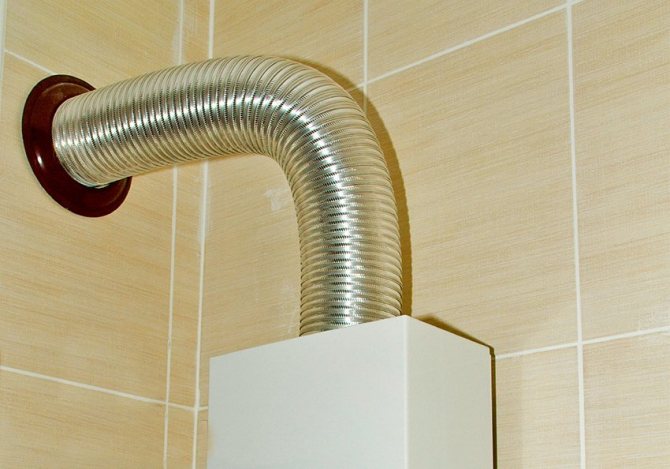

How to wash the inside
Less grease and dirt particles accumulate on the inner walls of the case, but it also needs to be washed periodically. Depending on the degree of soiling, different recipes are used, which are also suitable for cleaning the filter grate.The thick gel or paste can be left on the walls for a while and then wiped off with a sponge. A slight layer of greasy soot can be easily removed with liquid products without soaking.
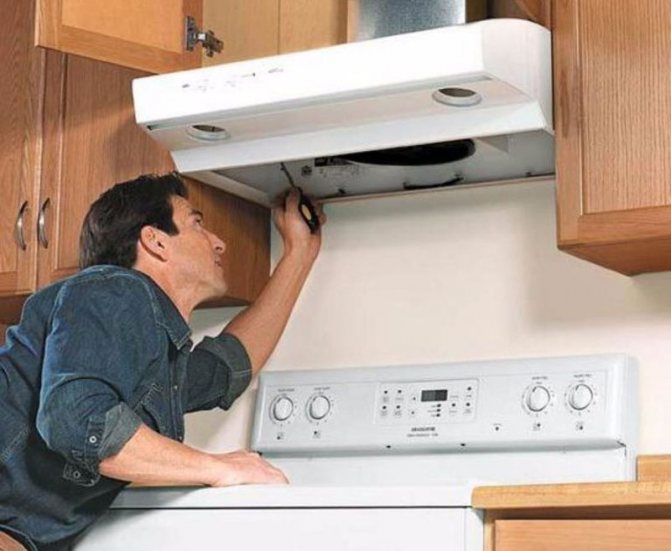

How to clean the motor and fan
The main moving parts of the hood should be cleaned every two years. To wash the motor, a complete disassembly of the device is required. The fan is disconnected from the motor. The fan wings should be washed in soapy water with a sponge. Allow the parts to dry completely before replacing them.
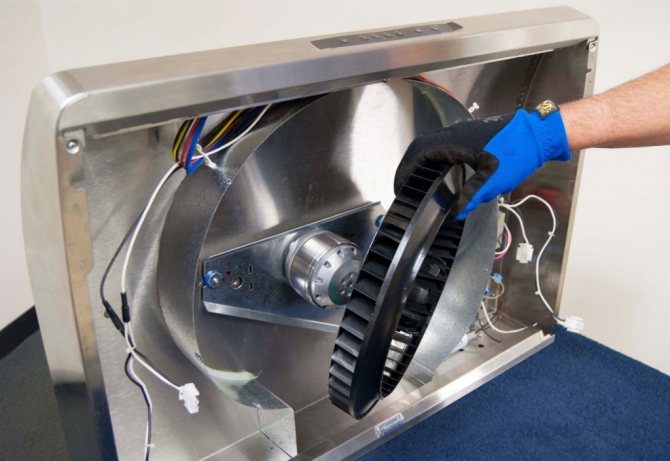

How to clean a cooker hood with caustic soda
If none of the above ingredients have worked for you before it is completely cleansed, or grease and oil stains have stuck into the surface, this can be a very effective solution. The acidic nature of caustic soda will easily remove greasy or oily stains.
Remove the filters from the chimney and place them on the pallet.
Sprinkle some caustic soda on the dirty surfaces.
Pour boiling water over them.
Do this carefully without inhaling the caustic vapors of the caustic soda.
Leave it on for 2 to 3 hours without stirring.
Clean them thoroughly and rinse them with clean running water.
Dry them thoroughly before putting everything back.
Be careful: Avoid touching the caustic soda with bare hands, as this can cause chemical burns. It is recommended to carry out this procedure while protecting your hands.
The technology of processing hood gratings in two ways: a comparative analysis
This experiment is conducted by the editors to show readers a real effective means for cleaning surfaces from large accumulations of fat.
| Illustration | Description of action |
| We take out the grates from the hood and process with different means. | |
| Apply generously to both nets and leave for 15-30 minutes. | |
| For the left grate, they used regular children's dish gel, and applied lemon juice on the right one. | |
| After the expiration of the time, we begin to clean the hoods mechanically. We use a metal brush or scraper. | |
| We rinse both parts under running water so that no coked dirt particles remain. |
As a result, we see that the children's dishwashing detergent "Eared nanny" copes with this kind of pollution more effectively. According to experts, any composition with a degreasing formula will cope with such tasks many times faster than folk methods.
The best ways to cleanse


Before you bring the filter with a thick layer of dirt adhered to perfect condition, it is advisable to pre-soak it in alkali or boil over low heat.
Soda and soap
Boiling
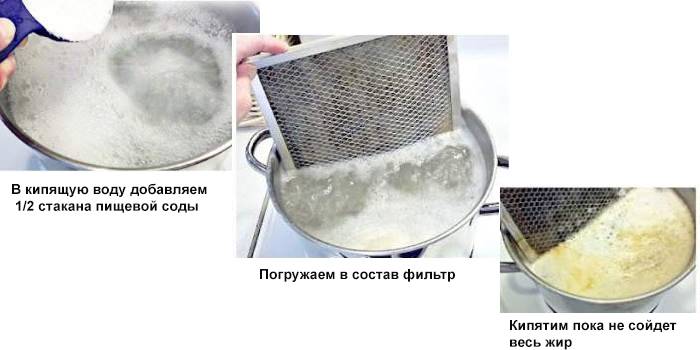

Laundry soap
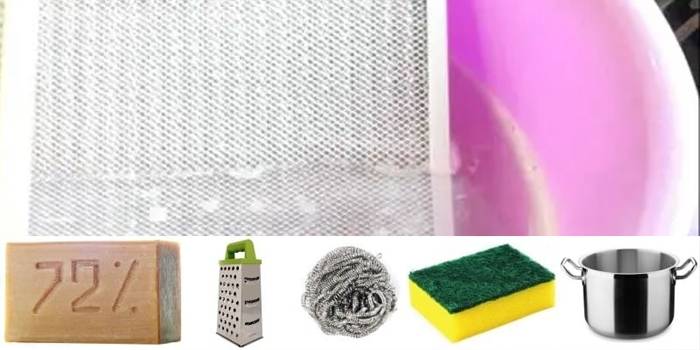

Pour 2.5-3 liters of water into an iron bowl or saucepan, put on fire.
- Add half a bar of grated soap.
- Wait for the soap to dissolve and remove the basin from the stove.
- Place the wire rack in a container for 15-20 minutes.
- Clean the filter with a sponge. It will not hurt to wipe the hood body with the same solution.
- Place the filter on a baking sheet and pour the detergent gel over the top.
- Spread the gel evenly over the mesh with a toothbrush.
- Leave the liquid on the filter for deep penetration into the greasy layer for 1 hour, rinse with clean water.
- Wash the filter in the dishwasher in an upright position with the addition of detergent.
Soaking in vinegar
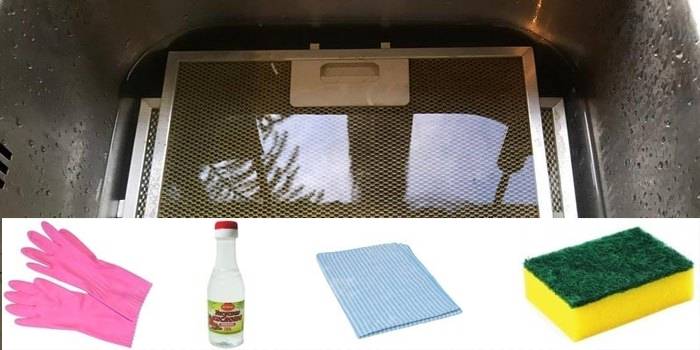

A supply of fresh air should be provided before processing, and rubber gloves should be used when soaking. To cleanse, you need a rag soaked in vinegar. They wipe the places of fat accumulation with it and wait 10-15 minutes, then the filter is washed in hot water and rinsed thoroughly.
Dishwasher
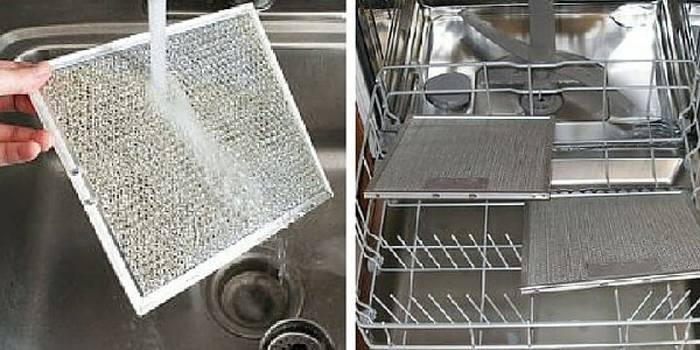

The water temperature should not be too hot - the metal from which the filter is made can oxidize and change color.
The sequence of actions is as follows:
Fill a sink with warm water and dip the soaking grate into it for a few minutes.
Lemon
Grease remover
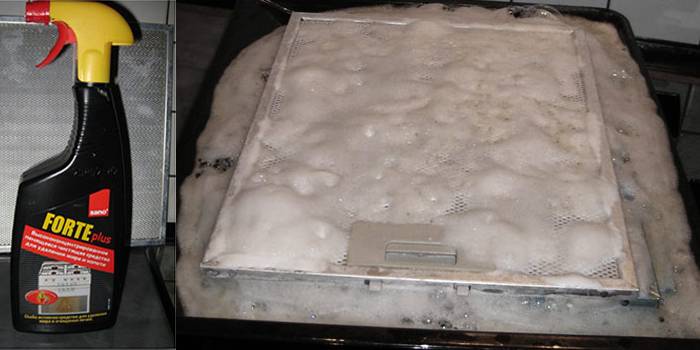

Processing is carried out with an open window in protective gloves. It is advisable to place the lattice greased with a caustic agent in a bag for 15 minutes to avoid the spread of an unpleasant odor.
An aqueous solution of ammonia - ammonia - has a similar effect. If you pour it into a tight plastic bag and put the filter inside for several hours, the grease will dissolve without a trace. After a long rinse, the mesh should be taken out into fresh air to weather the remains of the pungent odor and left outside until completely dry.
